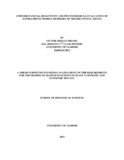| dc.description.abstract | Intestinal worms affect a host of individuals resulting in malnutrition, stunted growth,
intellectual retardation and cognitive deficits. The aim of this study was to investigate the
indigenous plants of Migori County with anthelmintic activity using adult Haemonchus
contortus worm as a model and determining the presence of active principles. Twenty six (26)
herbalists between the ages 20-69 years (10 men and 16 women) were interviewed on plants
used as anthelmintics. Local name, parts used, mode of preparation and administration were
documented. There was a high correlation (r=0.96) between age of informants and number of
medicinal plant citations. The study identified 21 anthelmintic plants distributed among 21
genera and 13 families. The plant families most commonly used includes Asteraceae (27.72%),
Leguminosae (15.79%) and Lamiaceae (10.53%). The three most frequently used plants: Eclipta
alba (Asteraceae), Vernonia amygdalina (Asteraceae) and Plectranthus barbatus (Lamiaceae)
were collected, extracted in methanol, acetone and distilled water for phytochemical studies. The
phytochemical screening focussed on saponins, tannins and cardiac glycosides using standard
procedures. In-vitro anthelmintic activities study of crude extracts of these selected plants were
also done using adult Haemonchus contortus worms to test their potency. The anthelmintic
activity of 6.25 mg/ml, 12.5 mg/ml and 25 mg/ml concentrations of aqueous, acetone and
methanol crude extracts of Eclipta alba (whole plant), leaf and root extracts of Vernonia
amygdalina and leaf extract of Plectranthus barbatus were compared with the effect produced
by the standard reference drug albendazole. Extracts at 25 mg/ml concentrations were most
active. Phosphate Buffered Saline (PBS) was used as a negative control. Death was determined
within a period of 24 hrs. Extracts tested were active against Haemonchus contortus except 6.25
mg/ml concentration of acetone extract of P. barbatus. Eclipa alba (whole plant) extract was the
most potent followed by Vernonia amygdalina root extract. Plectranthus barbatus leaf extract
was the least potent. Albendazole had an overall average MI of 1.00 which translates to 100%
potency. Analysis of variance revealed that there were significant differences in the anthelmintic
activity of the plants’ extracts of all the concentrations (6.25, 12.5 and 25 mg/ml) used at
p 0.05. All the three plant extracts exhibited anthelmintic activity therefore could be a cheap
and readily available alternative source of anthelmintic treatment. | en_US |

